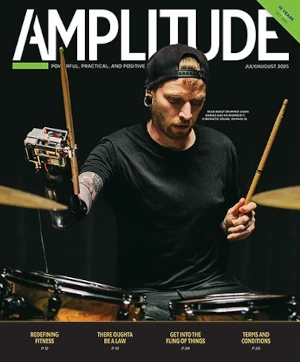Water sports have relatively low barriers to entry for amputees, and they’re rejuvenating for mind, body, and spirit.
By Mindy Best

After an hour of practicing emergency exits in the pool, Anna Corbitt had to be dragged out of the water. She was having so much fun that she wanted to keep going.
A congenital quadruple amputee from St. Louis, Missouri, Corbitt is top heavy, doesn’t float well, and has a slight fear of water. She’d be the first to laugh at how that sounds. “It’s great to be around people who understand my situation,” she says. “I can be myself and make self-deprecating jokes without any awkwardness, because everyone gets it.”
That’s not always the case for Corbitt, who finds it easy to fall and hard to feel comfortable. But once she got into the pool, Corbitt discovered that she could still be in control. “Being in the water feels incredibly freeing,” she says.
Corbitt’s experience illustrates how beneficial water sports can be for people with limb loss, both mentally and physically. In contrast to land sports, water sports are generally low impact, so you don’t feel as much wear and tear on your residual limb(s) or anywhere else. Our bodies are naturally buoyant, so it’s easier to move in or on the water than on land, enhancing mobility. Water also provides natural resistance that helps strengthen your muscles and improve your balance and coordination. And many water sports don’t require a prosthesis, liberating you from the weight and discomfort of your artificial limb.
Beyond the physical activity itself, adaptive water sports are often therapeutic and calming or energizing and empowering. They’ve helped thousands of people get active after limb loss to regain their confidence and independence.
“If there’s magic on this planet, it’s in the water,” says Larry Gioia, an adaptive paddling instructor who routinely introduces amputees to canoeing and kayaking through his boating program, Dynamic Paddlers. “I’ve seen the transformative effect it’s had on individuals, couples, and families.”
“If someone invites you [to try water sports], you have to say yes,” adds Chris McClanathan, a medically retired Army veteran and bilateral leg amputee from Southern California. “Don’t worry so much about how it’s going to happen. You have to be flexible and creative, but first you just have to show up.”
Whether this is your first time or your hundredth time in or on the water, many resources are available to help you create a plan and follow through. Here’s an introduction to a handful of adaptive water sports that are growing in popularity, along with some tips to help you get started.
Surfing
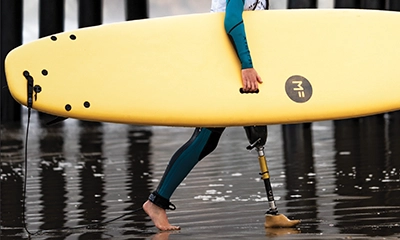
Angie Heuser’s first amputee surfing experience came during her family’s annual vacation in Hawaii. A left above-knee amputee from Phoenix, Heuser hadn’t been able to enjoy the beach in years because of the limitations from her chronically injured left leg. But after her amputation in 2019, Heuser felt a new sense of freedom.
“Surfing started as a desire to do what people wouldn’t think I could do and wanting to prove I could do anything, even one leg down,” says Heuser. She took lessons at a surf school, but the instructors weren’t specialized in working with amputees, so she had to figure out a lot on her own. She was surprised by how sore her ribs were the day after, but the pain was well worth the high she felt for months after catching her first wave.
“It’s an amazing feeling once you get out on the water,” she says. “The power of that wave comes from beneath the water’s surface. To start to paddle with that power just below you and then to stand and be driven forward by it, it’s a feeling like no other.”
Adaptive surfing has drawn a huge following among not only amputees but also people with other disabilities. Its popularity is driven in part by high-profile competitions all over the globe. The sport’s international governing body is pushing to get adaptive surfing included as a medal sport in the 2028 Paralympics.
Kayaking and Canoeing
Alan Parrish, a Marine Corps veteran and below-knee amputee from Cleveland, first tried adaptive kayaking at a local workshop, where he learned how to paddle, roll, recover, and rescue himself. He enjoyed it so much that he bought two of his own kayaks, which he calls Little Orange and Big Red. Parrish typically takes Little Orange out on the river. When he’s exploring a lake, where larger waves are more common, he feels more comfortable in Big Red.
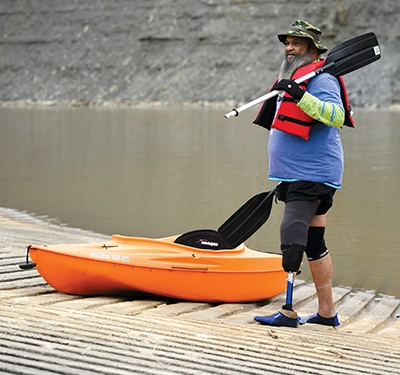
Photo by Alan Denver.
“When I first lost my leg, I didn’t have a good outlook on life,” Parrish says. “But when I’m out on the water, it gives me a mental boost. I make a plan for the day—where I’m going, what type of water I’ll be on, what steps I need to take to ensure I have a great day. I’m focused and motivated.”
When Parrish first got into paddling, he didn’t have a water leg, so he and his instructor figured out some adaptations to make it safe for him to kayak with a regular prosthesis. “I just didn’t want to fall out of the boat and make a fool of myself—or drown,” Parrish laughs. “You have to have a rescue plan. I’m a big guy, so rescue for me looks different than it would for someone smaller. With a personal flotation device, I can push myself to the shore. Better yet, I try to avoid falling out by paying attention to my surroundings. If I’m on a lake, I paddle into the waves, even if it goes against my instincts, to keep from tipping over.”
Parrish’s first adaptation was made of foam that fit into his socket and mount. The materials changed over time, but the goal was always the same. “Basically, I needed to get both limbs in contact with the boat, so I wouldn’t go in circles,” says Parrish. “I needed two points to push off of, so I could paddle on both sides and control the direction of the boat.”
Parrish eventually did get a water leg, so he no longer needed a boat adaptation. But once he bought his own boat, he had to figure out how to load and unload it from his car, get it into the water, and then get it back onto the roof rack. Finding an accessible boat launch at a local park was a game changer, Parrish says. Its transfer bench and slide boards allow him to get his kayak into and out of the water with ease.
“I enjoy the view from the boat and seeing things along the shoreline,” Parrish says. “It’s like reading a book about different experiences. My soul feels free.”
Scuba Diving
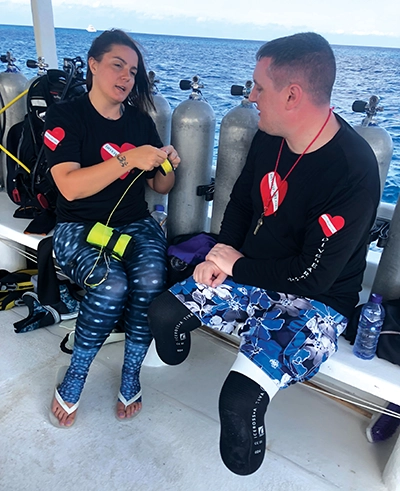
Photo courtesy Diveheart.
Chris McClanathan took his first scuba lesson in a heated pool during a week-long VA camp for wounded veterans. His buoyancy as a bilateral amputee was different than before his amputation, so he had to relearn how to swim and float.
McClanathan kept working at it and eventually earned certification from Diveheart, an adaptive-sports nonprofit that operates in Illinois, Georgia, and elsewhere. His certification enables him to scuba dive in any setting, even with outfitters that don’t have specific expertise with adaptive divers. McClanathan can self-advocate because he knows what his abilities are and how to take care of himself during a dive. He uses an AMP Fin, a mechanical accessory that attaches to his prosthetic socket for swimming and diving, and Darkfin gloves with webbing on the back that allows him to manipulate his equipment while in the water.
A well-kept secret about scuba diving is that it’s one of the more accessible water sports. Most beginner lessons are held in swimming pools, so you can try it out at a local rec center instead of traveling to an oceanside location. Masks, tanks, and other equipment are all usually provided by the dive school, and you don’t have to be in great shape to sign up.
“Many skills are transferrable,” McClanathan says, “so if you learn techniques for an activity on land, you can carry it forward in the water.” So why don’t more amputees try scuba diving? “The biggest barriers are often in one’s own head,” he says. “I wasn’t into sports much growing up, but I’ve tried a lot of them for the first time after amputation. It’s never too late to start.”
Once you try scuba, your only regret may be that you didn’t get started sooner.
Wakesurfing
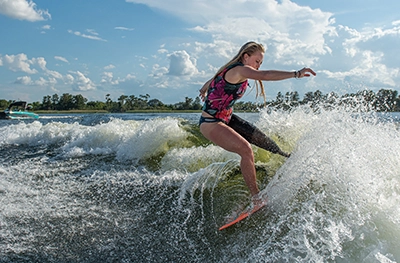
Lexi Kuppler grew up next to a lake and always felt at home on the water. That didn’t change even after she lost her left leg below the knee in a boating accident during high school. An all-around athlete, she ran track in college and competed in the 2016 Summer Paralympics in Rio. But water sports remained her first love.
That’s why she established a nonprofit called Brave the Wave. The organization holds events across the country to promote the sport of adaptive wakesurfing. A mashup of surfing, water skiing, and skateboarding/snowboarding, wakesurfing is a relatively new sport, particularly for adaptive riders. Participants stand on a modified surfboard and glide across a lake, dipping in and out of the waves that trail behind the boat.
“Wakesurfing is very adaptable to people of all ages, body types, and abilities,” says Kuppler. “It’s low impact, as you ride close to the boat at a low speed, and you can adapt the rider or the board in many ways.”
The biggest challenge, Kuppler says, is getting up on the board while the boat’s moving, especially if you’re a double above-knee amputee. “A coach in the water can help people get up and stabilize them, or coaches can ride tandem on the board,” she says. “We also have a seated cage that can be screwed on to surfboards and allows adaptive wavesurfers to ride just as intensely as anyone.”
The goal, she says, is to enable people to feel independent on and off the water. “Since the start of our program, we’ve seen people get inspired to eat healthier, try new things, and take control of other health issues,” Kuppler told a surfing website recently. “It’s truly a blessing to be able to help show people what they’re capable of.”
Dip a Toe Before You Dive In
Cosi Belloso, the amputee-focused physical therapist who hosts the popular Cosi Talks! show every week on YouTube, believes water sports can play an important role in rehab and long-range fitness.
“Sometimes my patients hesitate because they’re afraid I’ll tell them no,” Belloso says. “I want them to find a good starting point and set realistic expectations, but almost anything is possible.” Belloso suggests starting with the basics: how to get in and out of the water. “Start out small, with low expectations,” she advises. “Just go to a pool and see the environment, meet the lifeguard. Know that you’re going to run into obstacles, and that’s okay.”
Public pools often have pool lifts, aquatic wheelchairs, sloped entrances, or walk-in entries and handrails that can help amputees get in and out of the water. Outdoor environments (such as riverbanks or lakes) may offer support systems to help you navigate uneven and/or unpaved terrain. “You could be walking on different surfaces, going up or down steps or getting into a boat that’s rocking back and forth,” Belloso says. “Everything is constantly moving, and you need to be able to keep your balance.”
Larry Gioia, who holds special certification in adaptive paddling instruction from the American Canoe Association, starts newcomers at a county park near Pittsburgh. It’s a contained environment with relatively warm water and no power boats nearby. “I know kayaking, but my clients know themselves and their abilities,” he says. “Together, we figure out what we need to do to be realistic and keep them safe.”
Gioia shifted from traditional instruction to adaptive paddling several years ago. He got the idea after he saw a young boater zig-zagging all over the place instead of maintaining a straight line. When he got closer, Gioia saw the kid paddling with one arm. The incident inspired him to launch Dynamic Paddlers, which promotes adaptive canoeing and kayaking and provides high-quality education to kids and adults.
“My mission is simple,” Gioia says. “I want to help everybody and anybody who wants to get on the water. I want them to learn to paddle with the same confidence and independence as everybody else. Water is the ultimate equalizer. I can show you a picture of 20 boats, and you can’t tell me who in this picture has a disability and who doesn’t.”
The near-universal accessibility of water sports is what draws so many amputees to them, Gioia believes. Whether you’re an adventure seeker, retired veteran, aspiring Paralympian, or simply a person looking for something new to try, adaptive water sports offer an outstanding way to reach your goals and improve your quality of life.
“Surround yourself with good people, and connect with good programs and organizations,” says Corbitt. “You want to find people who know what they’re doing to make your experience safe, comfortable, and fun. Choose the opportunities that are right for you.”
Sidebar: Water Sports and Prosthesis Safety
“But what about my prosthesis?”
That’s a major question for any amputee who wants to try water sports. Your everyday limb probably isn’t waterproof, and waterproof limbs are expensive to purchase. You don’t need a prosthesis for some water activities, but you do for others. Specialized equipment and adaptations can allow you to feel safe and comfortable in the water. Figure out what works for you and what doesn’t, communicate what you need, and recalibrate and adjust as necessary.
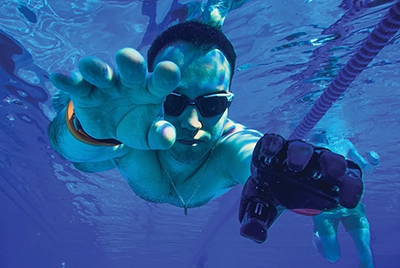
“As long as you’re wearing the right equipment, you can focus on just having fun,” says certified prosthetist Dave Rotter. While custom and commercial adaptations are readily available, you don’t have to commit to buying anything when you first get started. Improvised solutions are fine at first. Gioia once made a hand for an arm amputee out of foam and duct tape in his garage. Rotter suggests working with your prosthetist to find safe, sensible workarounds.
Belloso suggests that you don’t wear a prosthesis at all in the water. If you absolutely need one, she advises clients to hang on to their old sockets and add a cheap foot for a water leg. Start basic, she says. You don’t need fancy technology. Sometimes you might just need an extra lanyard strap or pin-lock to do the trick.
If you do have the funds and the need to buy your own equipment for water recreation, Belloso recommends College Park’s Sidekicks and Breeze for feet. The Sidekicks are multiaxial, adjustable stubbie feet with nice tread and some movement. Belloso recommends them especially for the pool, beach, and paddleboarding. The Breeze has a built-in drainage system and is durable and antimicrobial, which makes it a great option for a variety of outdoor adaptive water sports.
Both Rotter and Kuppler like BioDapt’s Versa foot. Kuppler, who studied kinesiology and prosthetics/orthotics in college, provides BioDapt feet and knee loaners at all her Brave the Wave events. “The key for wavesurfing is to have a knee that locks into position and doesn’t move,” she says. Arm amputees at her events often use deadlifting straps to help them with grip.
Finally, Belloso says, take extra care of your skin whenever you hit the water. Skin changes when it’s immersed, and that can affect socket fit, which in turn can lead to blisters or sores. She recommends that you take your prosthesis off every 30 minutes or so to dry it out and keep an eye on how your skin’s reacting.
Beginner’s Guide to Adaptive Water Sports
Here’s a short list of organizations that offer adaptive water sports programs for amputees. To locate a program near you, visit Amplitude’s website and use our new Amputee Community Resource Directory.
SCUBA
Dive Pirates: Chapter-based adaptive scuba school has affiliates in 20 states. divepirates.org
Diveheart: Award-winning nonprofit operates in Illinois, Florida, and Georgia. diveheart.org
Dive Guardians: California-based outfit specializes in post-traumatic rehabilitation. diveguardians.org
WAKESURFING
Brave the Wave: California-based nonprofit holds free events across the country. bravethewave.co
SURFING
AmpSurf: Twenty-year-old organization serves kids, adults, and veterans on both coasts. ampsurf.org
Operation Surf: Uses surf therapy to help wounded warriors heal physically and emotionally. operationsurf.org
PADDLING
Dynamic Paddlers: American Canoe Association-certified instruction in adaptive paddling. dynamicpaddlers.com
Adaptive Adventures: Colorado program teaches kayaking, rafting, paddleboarding, and dragon boating. adaptiveadventures.org



